Walter Runeberg
Walter Magnus Runeberg (Finland Swedish: [ˈrʉːnebærj]; 29 December 1838 – 23 December 1920) was a Finnish neo-classical sculptor.[1] He was the son of Finnish national epic poet Johan Ludvig Runeberg.[2]
Walter Runeberg | |
|---|---|
.jpg.webp) Portrait photograph of Walter Runeberg, 1870–1875 | |
| Born | Walter Magnus Runeberg 29 December 1838 |
| Died | 23 December 1920 (aged 81) Helsinki, Finland |
| Nationality | Finnish |
| Known for | Sculpture |
| Movement | Neo-classical |
| Spouse |
Lina Elfving
(m. 1867; died 1916) |
Biography
Runeberg was born in Porvoo as the eldest son of J. L. Runeberg and his wife, Fredrika Tengström. He studied at the Academy of Fine Arts, Helsinki, and with sculptor Carl Eneas Sjöstrand.[1] From 1858 through 1869 he studied at the Royal Danish Academy of Fine Arts in Copenhagen under Herman Wilhelm Bissen, acquiring a clear influence from the neoclassical style of Bissen's master Bertel Thorvaldsen.[1] He married Lina Elfving (1841–1916) in 1867. They had six children.[1]

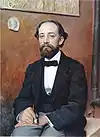
After periods living and working in Rome and Paris,[1][3] Runeberg produced many of Helsinki's best-known examples of monumental public art. The largest is the Alexander II Monument in Senate Square, a commission awarded jointly to Runeberg and sculptor Johannes Takanen, then completed by Runeberg after Takanen's death in 1885.[4] The pedestal features several allegorical figures. Notably, the figure representing Law is a version of the Suomi-neito, the Finnish maiden, here cloaked in bearskin.[5]
_(cropped).jpg.webp)
He is buried in the Hietaniemi Cemetery in Helsinki.[6]

Works
Statue of Alexander II
 Alexander III being shown a work-in-progress of the statue of Alexander II on 9 August 1885 at House of Nobility
Alexander III being shown a work-in-progress of the statue of Alexander II on 9 August 1885 at House of Nobility Reveal of the statue of Alexander II on 29 April 1894 at Senate Square
Reveal of the statue of Alexander II on 29 April 1894 at Senate Square The statue with its accompanying structure
The statue with its accompanying structure The statue itself up close from the front
The statue itself up close from the front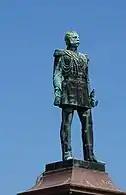 Alexander II from the side
Alexander II from the side.jpg.webp) Close-up from the front with Helsinki Cathedral's John the Apostle in the background
Close-up from the front with Helsinki Cathedral's John the Apostle in the background_monument_Helsinki_HDR_2008.jpg.webp) Statues at the bottom, with the four sides representing Law, Trade, Peace and Labor
Statues at the bottom, with the four sides representing Law, Trade, Peace and Labor Law
Law Trade
Trade Peace
Peace Labor
Labor_p247_SCIENCE_AND_ART.jpg.webp) Model for Trade, called Science and Art
Model for Trade, called Science and Art_p165_LAW.jpg.webp) Model for Law
Model for Law One of the two copies of Law displayed at the Presidential Palace (pictured in 2001)
One of the two copies of Law displayed at the Presidential Palace (pictured in 2001) The other copy at the House of the Estates
The other copy at the House of the Estates
Other notable works
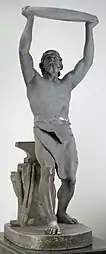 Ilmarinen Forging the Moon, 1866
Ilmarinen Forging the Moon, 1866 Apollo and Marsyas at the entry lobby of Ateneum, 1874
Apollo and Marsyas at the entry lobby of Ateneum, 1874 1885 reveal of the statue of Johan Ludvig Runeberg, his father
1885 reveal of the statue of Johan Ludvig Runeberg, his father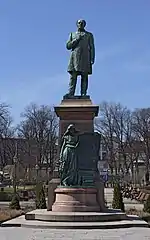
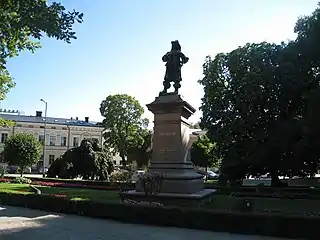 Per Brahe Statue in Turku, 1888
Per Brahe Statue in Turku, 1888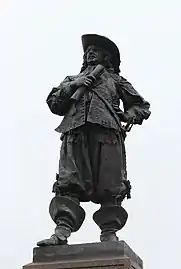 Slightly larger version of the same Per Brahe statue in Raahe from the same year
Slightly larger version of the same Per Brahe statue in Raahe from the same year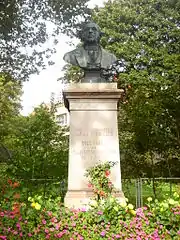 Henrik Borgström monument, Taka-Töölö district of Helsinki, 1888
Henrik Borgström monument, Taka-Töölö district of Helsinki, 1888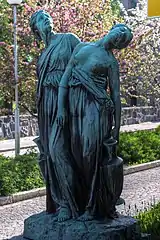
![Allegorical figures on the exterior of the rotunda, National Library of Finland, with fellow sculptor Karl Magnus Mellgren [fi], 1905](../I/National_library_of_Finland_rotunda_1.JPG.webp) Allegorical figures on the exterior of the rotunda, National Library of Finland, with fellow sculptor Karl Magnus Mellgren, 1905
Allegorical figures on the exterior of the rotunda, National Library of Finland, with fellow sculptor Karl Magnus Mellgren, 1905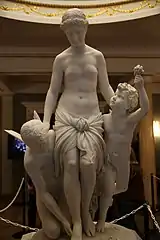

See also
References
- Lindgren, Liisa (9 October 2006). "Runeberg, Walter (1838 - 1920)". Kansallisbiografia. Retrieved 23 June 2020.
- "Walter Runeberg Collection :: The Saatchi Gallery". www.saatchigallery.com. Archived from the original on 2014-02-01.
- "Walter Runeberg". Porvoo. Retrieved 23 June 2020.
- http://www.taidemuseo.fi/english/veisto/veistossivu.html?id=317
- Undressing the maid: gender, sexuality, and the body in the construction of the Finnish nation, Johanna Valenius, 2004, page 20
- "Hietaniemen hautausmaa – merkittäviä vainajia" (PDF). Helsingin seurakuntayhtymä. Retrieved 27 August 2016.
- "ohan Ludvig Runebergin muistomerkki/ Johan Ludvig Runeberg's memorial". HAM Helsinki. Retrieved 23 June 2020.
- "Kleobis ja Biton / Cleobis and Biton". HAM Helsinki. Retrieved 23 June 2020.